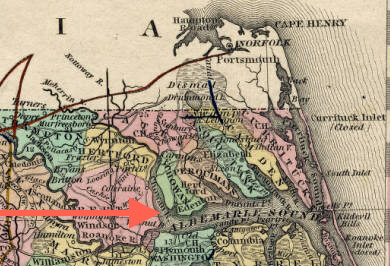Northeast North Carolina Underground Railroad: Sea, Swamp, Solidarity
/In researching the life of Harriet Jacobs in the North after 1842, I am trying to learn as much as I can about what happened to help in her escape. As readers of Incidents in the Life of a Slave Girl know, she grew up enslaved in Edenton, in northeastern North Carolina.
Two geographic features made a huge difference in how she ultimately escaped: the sea and the swamp. In addition, a third feature—kinship and friendship ties—also boosted her probability of a successful escape and reception in the North.
Much of what I summarize below comes from two presentations you can view online: Northeastern North Carolina’s Underground Railroad, produced by the Museum of the Albemarle. and “Conductors and Passengers: Harriet Jacobs’ Underground Railroad,” a presentation by historian Mary Maillard as part of a lecture series sponsored by three Edenton organizations.
Maritime Underground Railroad
Detail of map published in 1839 shows Edenton’s link to the ocean. Map in the Maps of North Carolina archive.
As this map shows, a network of waterways connects Edenton to the Atlantic Ocean. Commerce in the mid-1800s was lively. Ship crews included free and enslaved Blacks (such as Harriet Jacobs’s Uncle Mark), as described by historian Ben Speller in the video referenced above. They passed on news of the world beyond North Carolina, as well as information about ship routes and schedules, at great personal risk. They and any captains who transported freedom seekers were severely punished if caught—imprisonment, fines, enslavement (for African Americans, even those legally free), and execution.
Still, many participated in the so-called Maritime Underground Railroad that brought freedom seekers from the South to the ports of Philadelphia, New York, and Boston. Vigilance Committees and other groups welcomed them, often right on the docks, with food, shelter, and invaluable advice about what to do next.
In Incidents in the Life of a Slave Girl, Harriet Jacobs wrote about the relief to be on deck in the open air, sailing to freedom. Then:
Ten days after we left land we were approaching Philadelphia. The captain said we should arrive at night, but he thought we [Harriet and another Black woman] had better wait until morning and go on shore in broad daylight, as the best way to avoid suspicion.
After all this time and travail, however:
He saw that I was suspicious, and he said he was sorry, now that he had brought us to the end of our voyage, to find I had so little confidence in him. Ah, if had ever been a slave he would have known how difficult it was to trust a white man.
Despite her understandable anxiety, Harriet Jacobs set foot on Pennsylvania soil the next day.
Great Dismal Swamp
Before hiding in her grandmother’s attic and her eventual (7 years later!) escape by sea, Harriet Jacobs spent a few days hiding in what she called Snaky Swamp in Incidents, "covered with hundreds of mosquitos…snake after snake crawling around us….”
Besides the snakes and mosquitos, she felt alone—but, largely speaking, she was not.
She hid in the southern reaches of the Great Dismal Swamp, which then stretched across 1 million acres from Norfolk, Virginia, down into North Carolina. It’s now a fraction of that size, but includes land preserved as state and federal parks. Laborers (mostly enslaved people) did back-breaking work to build a canal through the swamp in the late 1700s and early 1800s.
Its conditions and remoteness also provided sanctuary. According to historians Wanda Hunt McLean and Dr. Speller, generations of people escaped slavery and lived in its inaccessible reaches for years, living off the land and raising families.
An archaeological project has excavated one area and found thousands of artifacts, such as tools and cabin remains. A group of descendants has also traced the history to preserve it.
Kinship and Friendship
How to navigate these physical features? Go left, go right, or stay in place? Freedom seekers had to make split-second decisions about whom to trust and whom to fear as they made their way north. In addition to strength and ingenuity, luck played a role to connect with family, friends, friends of friends, and others. If not, disaster.
In the talk mentioned above, historian Mary Maillard explored the links that Jacobs already had with the Philadelphia anti-slavery community, based on shared Edenton ties. Specifically, a Black, legally freed woman named Edy Wood had moved from North Carolina to Philadelphia in the early 1830s. Her older daughter Mary became active in the Philadelphia Female Anti-Slavery Society and Philadelphia Vigilance Committee, which provided valuable aid to Harriet when she arrived in 1842.
Two formerly enslaved Black men from Edenton—Geoffrey Iredell, Jr., and George Lowther—were also established in Philadelphia and Boston respectively. Jacobs would have known them in Edenton and could connect with them when she escaped. (Years later, the published edition of Incidents included a testimonial signed by Lowther that “the circumstances recounted in her history are perfectly familiar to me.”)
Just as Jacobs benefited from this assistance, she provided material and emotional support to others.


